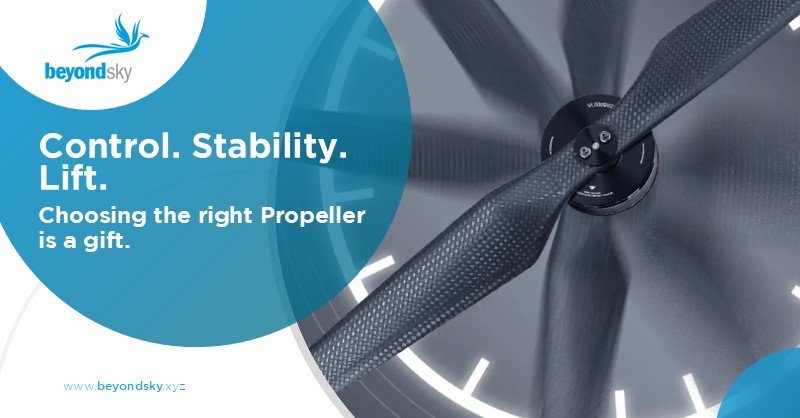How to Choose the Right Drone Propeller


Holding a new set of propellers for your drone, you might suddenly wonder: "Will these actually make my flights better?"
If you choose wisely, then yes. Drone propellers are like the shoes on a runner - the right pair can transform your performance, while the wrong ones will hold you back every flight.
Whether you're flying a tiny indoor quad or piloting a heavy-lift commercial platform, your propeller choice directly impacts everything from flight time to stability. Let's walk through what you need to know to make the best selection for your specific needs.
Every propeller has three key measurements that tell you everything: diameter, pitch, and blade count. If you see "5x4x3" on a propeller, that means 5 inches across, 4 inches of pitch, and 3 blades.
The diameter is simply how wide the spinning circle is. Bigger propellers move more air but need stronger motors and make your drone less nimble. The pitch is trickier to understand - imagine the propeller as a screw boring through wood. The pitch tells you how far it would advance in one complete turn.
Plastic propellers are where most pilots start. They're cheap, light, and forgiving when you inevitably crash. They flex during flight, which actually absorbs some vibration, but they also break easily.
Carbon fiber propellers are the performance upgrade. They're stiffer, lighter, and last longer, but they'll cost you significantly more. Racing pilots and professionals swear by them for good reason - the difference in responsiveness is immediately noticeable.
Nylon composite propellers split the difference. They give you better durability than plastic without the high cost of carbon fiber, making them perfect for serious hobbyists and semi-professional work.
Most drones use fixed propellers - simple, reliable, and effective. They work well but create drag when your drone isn't flying.
Folding propellers solve the portability problem. The blades fold back when not spinning, making your drone much easier to pack and transport. If you've ever tried to fit a Mavic in a small bag, you understand why this matters.
Mini drone propellers are specifically engineered for small spaces and indoor flying. They're usually 2-4 inches across and prioritize quick response over raw power.
Your flying style and goals should drive your propeller selection more than anything else.
When every vibration shows up in your footage, propeller choice becomes critical. Lower pitch, well-balanced propellers minimize shake and give you precise control for those perfect shots.
Three or four-blade designs often work better for camera work because they produce steadier thrust. Consider noise levels too - more blades usually mean quieter operation.
Racing is all about maximum performance. Two-blade propellers with aggressive pitch give you the speed and acceleration needed for competitive flying.
Durability matters in racing because crashes happen regularly. While carbon fiber performs best, factor in replacement costs versus plastic alternatives for practice sessions.
Professional applications demand proven reliability and often require specific certifications. Choose propellers from established manufacturers with documented performance data.
Heavy-lift missions need larger diameter propellers to generate thrust efficiently. Calculate your payload needs carefully and select propellers that provide adequate safety margins.
Indoor flying has unique safety requirements. Mini drone propellers typically feature ducted or shrouded designs to protect people and property from spinning blades.
Lightweight construction is crucial to minimize damage from inevitable wall collisions. Plastic propellers are usually the safest choice for indoor environments.
Quick responsiveness matters more than raw power for navigating tight indoor spaces.
For those looking to buy drone propellers online, BeyondSky offers several excellent options.
The Reflex Drive collection includes the RD 2388 Folding (23-inch carbon fiber for heavy-lift), RD 1760 Folding (17-inch for versatile applications), and RD 1552 Folding (15-inch polycarbonate for mid-range use).
T-Motor's VTOL-specific propellers are designed for vertical takeoff applications. All options come with proper technical specifications and motor compatibility information to ensure optimal performance.
With proper selection, maintenance, and care, good propellers will serve you well through countless flights, helping you capture better footage, fly longer missions, and simply enjoy the experience of piloting your drone.
The numbers indicate diameter, pitch, and blade count. For example, "5x4x3" means 5 inches diameter, 4 inches pitch, and 3 blades. Diameter affects thrust output, pitch determines forward speed efficiency, and blade count influences stability.
Beginners should start with plastic propellers due to their affordability and crash forgiveness. Professionals often choose carbon fiber for superior performance, durability, and responsiveness, while nylon composite offers a middle ground for serious hobbyists.
Check your motor specifications for maximum propeller diameter and recommended pitch range. Ensure the mounting system (prop nuts, T-mount, or press-fit) matches. Brushless motors handle larger propellers better than brushed motors of similar size.
Choose folding propellers when portability is important, such as for travel or storage in tight spaces. They reduce transport size and drag when not spinning, making them ideal for portable consumer drones like the DJI Mavic series.
Low pitch propellers spin up quickly, respond faster to throttle changes, and create less vibration - perfect for aerial photography. High pitch propellers provide higher speeds and better forward flight efficiency but need more powerful motors.
Replace propellers every 50 flight hours or 200 flights, whichever comes first. Replace immediately if you notice any cracks, chips, bent areas, or unusual wear patterns. Never attempt to repair damaged propellers.
Choose lower pitch, well-balanced propellers with three or four blades for steadier thrust and reduced vibration. This combination minimizes camera shake and provides precise control for smooth footage.
Place the propeller on a balancing rod to identify heavy spots. Sand or trim heavy areas until the propeller remains level in any position. Proper balancing prevents vibration that can damage motors and affect flight quality.